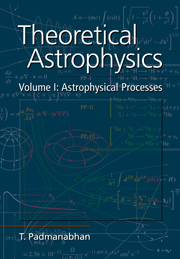Book contents
- Frontmatter
- Contents
- Preface
- Chapter 1 Order-of-Magnitude Astrophysics
- Chapter 2 Dynamics
- Chapter 3 Special Relativity, Electrodynamics, and Optics
- Chapter 4 Basics of Electromagnetic Radiation
- Chapter 5 Statistical Mechanics
- Chapter 6 Radiative Processes
- Chapter 7 Spectra
- Chapter 8 Neutral Fluids
- Chapter 9 Plasma Physics
- Chapter 10 Gravitational Dynamics
- Chapter 11 General Theory of Relativity
- Chapter 12 Basics of Nuclear Physics
- Notes and References
- Index
Chapter 3 - Special Relativity, Electrodynamics, and Optics
Published online by Cambridge University Press: 05 June 2012
- Frontmatter
- Contents
- Preface
- Chapter 1 Order-of-Magnitude Astrophysics
- Chapter 2 Dynamics
- Chapter 3 Special Relativity, Electrodynamics, and Optics
- Chapter 4 Basics of Electromagnetic Radiation
- Chapter 5 Statistical Mechanics
- Chapter 6 Radiative Processes
- Chapter 7 Spectra
- Chapter 8 Neutral Fluids
- Chapter 9 Plasma Physics
- Chapter 10 Gravitational Dynamics
- Chapter 11 General Theory of Relativity
- Chapter 12 Basics of Nuclear Physics
- Notes and References
- Index
Summary
Introduction
This chapter begins with a rapid overview of concepts from special relativity and develops the four-vector notation. Several aspects of electrodynamics are then introduced using special relativity and four-vector notation. Finally, this formalism is used to discuss some aspects of principles of optics that are relevant to astronomy. The concept of distribution functions, developed in Section 3.6, will be used extensively in several later chapters. This chapter will also be needed in the development of radiative processes (Chaps. 4 and 6), general relativity (Chap. 11), and in the study of cosmology in Vol. III.
The Principles of Special Relativity
The description of physical processes requires the specification of spatial and temporal coordinates of events that may be combined into a single entity characterised by the four numbers xi = (t, x). Throughout this chapter, the Latin indices a, b, …, i, j, etc., run over 0, 1, 2, and 3, with the 0 index denoting the ‘fourth’ dimension and 1, 2, and 3 denoting the standard space dimensions. The actual values of xi, attributed to any given event P, will depend on the specific coordinate system which is used. We pay special attention to a subset of all possible coordinate systems called inertial coordinate systems. Such coordinate systems are defined by the property that a material particle, far removed from all external influences, will move with uniform velocity in such systems.
- Type
- Chapter
- Information
- Theoretical Astrophysics , pp. 83 - 149Publisher: Cambridge University PressPrint publication year: 2000



